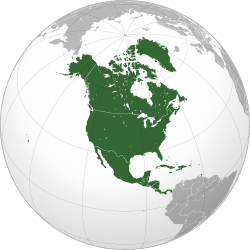Turks and Caicos Islands
The Turks and Caicos Islands (abbreviated TCI;[4] /tɜːrks/ and /ˈkeɪkəs, -koʊs, -kɒs/) are a British Overseas Territory consisting of the larger Caicos Islands and smaller Turks Islands, two groups of tropical islands in the Lucayan Archipelago of the Atlantic Ocean and northern West Indies.[5] They are known primarily for tourism and as an offshore financial centre. The resident population was 31,458 as of 2012[3] of whom 23,769 live on Providenciales in the Caicos Islands; July 2020 estimates put the population at 55,926.[4] It is the third largest of the British overseas territories by population.
Turks and Caicos Islands | |
|---|---|
| Anthem: "God Save the Queen" | |
| National song: "This Land of Ours"[1] | |
.svg.png) Location of Turks and Caicos Islands (circled in red) | |
| Sovereign state | United Kingdom |
| Treaty of Paris | 3 September 1783 |
| Federation | 3 January 1958 |
| Separate colony | 31 May 1962 |
| Capital | Cockburn Town |
| Largest city | Providenciales |
| Official languages | English |
| Ethnic groups | 88% Afro-Caribbean 8% Caucasian 4% mixed and East Indian |
| Demonym(s) | Turks and Caicos Islander |
| Government | Dependency under constitutional monarchy |
• Monarch | Elizabeth II |
• Governor | Nigel Dakin |
| Anya Williams | |
• Premier | Sharlene Cartwright-Robinson |
| Legislature | House of Assembly |
| Government of the United Kingdom | |
• Minister | Tariq Ahmad |
| Area | |
• Total | 616.3 km2 (238.0 sq mi) |
• Water (%) | negligible |
| Highest elevation | 157 ft (48 m) |
| Population | |
• 2020 estimate | 42,953 [2] (215th) |
• 2012 census | 31,458 [3] |
| Currency | United States dollar (US$) (USD) |
| Time zone | UTC-05:00 (EST) |
| UTC-04:00 (EDT) | |
| Date format | dd/mm/yyyy |
| Driving side | left |
| Calling code | +1-649 |
| UK postcode | TKCA 1ZZ |
| ISO 3166 code | TC |
| Internet TLD | .tc |
The Turks and Caicos Islands lie southeast of Mayaguana in The Bahamas island chain, northeast of Cuba, and north of the island of Hispaniola (Haiti and the Dominican Republic). Cockburn Town, the capital since 1766, is situated on Grand Turk Island about 1,042 kilometres (647 mi) east-southeast of Miami, United States. The islands have a total land area of 430 square kilometres (170 sq mi).[lower-alpha 1]
The Turks and Caicos Islands were inhabited for centuries by native Amerindian peoples. The first recorded European sighting of the islands occurred in 1512.[10] In the subsequent centuries, the islands were claimed by several European powers, with the British Empire eventually gaining control. For many years the islands were governed indirectly through Bermuda, the Bahamas, and Jamaica. When the Bahamas gained independence in 1973, the islands received their own governor, and have remained a separate autonomous British Overseas Territory since.[4]
Etymology
The Turks and Caicos Islands are named after the Turk's cap cactus (Melocactus intortus), and the Lucayan term caya hico, meaning 'string of islands'.[11][12][4]
History
Pre-colonial era
The first inhabitants of the islands were the Arawakan-speaking Taíno people, who most likely crossed over from Hispaniola some time from AD 500 to 800. Together with Taíno who migrated from Cuba to the southern Bahamas around the same time, these people developed as the Lucayan.[13] Around 1200, the Turks and Caicos Islands were resettled by Classical Taínos from Hispaniola.
European arrival
It is unknown precisely who the first European to sight the islands was. Some sources state that Christopher Columbus saw the islands on his voyage to the Americas in 1492.[13] However other sources state that it is more likely that Spanish conquistador Juan Ponce de León was the first European in Turks and Caicos, in 1512.[10][13] In any case, after 1512 the Spanish began capturing the Taíno and Lucayans as workers in the encomienda system[14] to replace the largely depleted native population of Hispaniola. As a result of this, and the introduction of diseases to which the native people had no immunity, the southern Bahama Islands and the Turks and Caicos Islands were completely depopulated by about 1513, and remained so until the 17th century.[15][16][17][18][19]
European Settlement
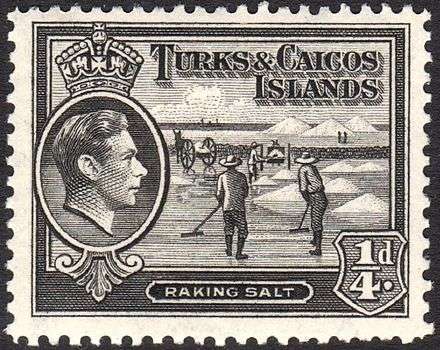
From the mid 1600s Bermudian salt collectors began seasonally visiting the islands, later settling more permanently with their African slaves.[20][13] For several decades around the turn of the 18th century, the islands became popular pirate hideouts.[20] During the Anglo-French War (1778–1783) the French captured the archipelago in 1783, however it was later confirmed as British colony with the Treaty of Paris (1783). After the American War of Independence (1775–1783), many Loyalists fled to British Caribbean colonies, also bringing with them African slaves.[13][20] They developed cotton as an important cash crop, but it was superseded by the development of the salt industry, with the labour done by African slaves forcibly imported from Africa or the other Caribbean islands and their descendants, who soon came to outnumber the European settlers.[13]
In 1799, both the Turks and the Caicos island groups were annexed by Britain as part of the Bahamas.[13][21] The processing of sea salt was developed as a highly important export product from the West Indies and continued to be a major export product into the nineteenth century.
19th century
In 1807, Britain prohibited the slave trade and, in 1833, abolished slavery in its colonies.[13] British ships sometimes intercepted slave traders in the Caribbean, and some ships were wrecked off the coast of these islands. In 1837, the Esperança, a Portuguese slaver, was wrecked off East Caicos, one of the larger islands. While the crew and 220 captive Africans survived the shipwreck, 18 Africans died before the survivors were taken to Nassau. Africans from this ship may have been among the 189 liberated Africans whom the British colonists settled in the Turks and Caicos from 1833 to 1840.[22]
In 1841, the Trouvadore, an illegal Spanish slave ship, was wrecked off the coast of East Caicos. All of the 20 man crew and 192 captive Africans survived the sinking. Officials freed the Africans and arranged for 168 persons to be apprenticed to island proprietors on Grand Turk Island for one year. They increased the small population of the colony by seven percent.[22] The remaining 24 were resettled in Nassau, Bahamas. The Spanish crew were also taken there, to be turned over to the custody of the Cuban consul and taken to Cuba for prosecution.[23] An 1878 letter documents the "Trouvadore Africans" and their descendants as constituting an essential part of the "labouring population" on the islands.[22] In 2004, marine archaeologists affiliated with the Turks and Caicos National Museum discovered a wreck, called the "Black Rock Ship", that subsequent research has suggested may be that of the Trouvadore. In November 2008, a cooperative marine archaeology expedition, funded by the United States NOAA, confirmed that the wreck has artefacts whose style and date of manufacture link them to the Trouvadore.[23][24][25]
In 1848, Britain designated the Turks and Caicos as a separate colony under a council president.[13] In 1873–4, the islands were made part of the Jamaica colony;[13] in 1894, the chief colonial official was restyled commissioner. In 1917, Canadian Prime Minister Robert Borden suggested that the Turks and Caicos join Canada, but this suggestion was rejected by British Prime Minister David Lloyd George and the islands remained a dependency of Jamaica.[26]
20th and 21st centuries
On 4 July 1959 the islands were again designated as a separate colony, the last commissioner being restyled administrator. The governor of Jamaica also continued as the governor of the islands. When Jamaica was granted independence from Britain in August 1962, the Turks and Caicos Islands became a Crown colony.[13] Beginning in 1965, the governor of the Bahamas was also governor of the Turks and Caicos Islands and oversaw affairs for the islands.[27]
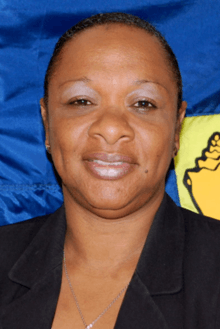
When the Bahamas gained independence in 1973, the Turks and Caicos received their own governor (the last administrator was restyled).[13] In 1974, Canadian New Democratic Party MP Max Saltsman tried to use his private member's bill C-249, "An Act Respecting a Proposed Association Between Canada and the Caribbean Turks and Caicos Islands" that proposed that Canada form an association with the Turks and Caicos Islands; however, it was never submitted to a vote.[28] Since August 1976, the islands have had their own government headed by a chief minister (now premier), the first of whom was James Alexander George Smith McCartney. Moves towards independence in the early 1980s were stalled by the election of an anti-independence party in 1980 and since then the islands have remained British territory.[13] Local government was suspended from 1986–88, following allegation of government involvement with drug trafficking which resulted in the arrest of Chief Minister Norman Saunders.[29][13]
In 2002 the islands were re-designated a British Overseas Territory, with islanders gaining full British citizenship.[13] A new constitution was promulgated in 2006, however in 2009 Premier Michael Misick resigned in the face of corruption charges, and the United Kingdom took over direct control of the government.[30][13] A new constitution was promulgated in October 2012 and the government was returned to full local administration after the November 2012 elections.[13][31]
In the 2016 elections, Rufus Ewing's Progressive National Party (PNP) lost for the first time since they replaced Derek Hugh Taylor's government in 2003. The People's Democratic Movement (PDM) came to power with Sharlene Cartwright-Robinson as Premier.[32][13]
Geography
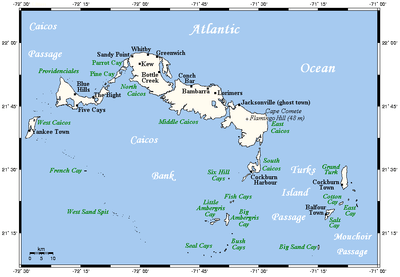
The two island groups are in the North Atlantic Ocean, southeast of the Bahamas, northeast of Cuba, about 160 kilometres (99 mi) north of Hispaniola, and about 1,000 kilometres (620 mi) from Miami in the United States, at 21°46′48″N 71°48′00″W. The territory is geographically contiguous to the Bahamas, both comprising the Lucayan Archipelago, but is politically a separate entity. The Caicos Islands are separated by the Caicos Passage from the closest Bahamian islands, Mayaguana and Great Inagua. The nearest foreign landmass from the Turks and Caicos Islands is the Bahamian island of Little Inagua, about 30 miles from West Caicos.
The eight main islands and more than 22 smaller islands have a total land area of 616.3 square kilometres (238.0 square miles),[lower-alpha 1] consisting primarily of low, flat limestone with extensive marshes and mangrove swamps and 332 square kilometres (128 sq mi) of beach front. The tallest peaks in the islands are Blue Hills on Providenciales and Flamingo Hill on East Caicos, both at a modest 48m.[4] The weather is usually sunny (it is generally regarded that the islands receive 350 days of sun each year[33]) and relatively dry, but suffers frequent hurricanes.[4] The islands have limited natural fresh water resources; private cisterns collect rainwater for drinking. The primary natural resources are spiny lobster, conch, and other shellfish.
The two distinct island groups are separated by the Turks Islands Passage.[5]
Turks Islands
The Turks Islands are separated from the Caicos Islands by Turks Island Passage, which is more than 2,200 m (7,200 ft) deep.[34] The islands form a chain that stretches north–south. The 2012 census population was 4,939 on the two main islands, the only inhabited islands of the group:
- Grand Turk (with the capital of the territory, area 17.39 km2 (6.71 sq mi),[35] population 4,831)
- Salt Cay (area 6.74 km2 (2.60 sq mi),[35] population 108)
Together with nearby islands, all on Turks Bank, those two main islands form the two administrative districts of the territory (out of six in total) that fall within the Turks Islands. Turks Bank, which is smaller than Caicos Bank, has a total area of about 324 km2 (125 sq mi).[36]
The main uninhabited islands are:
- Big Sand Cay
- Cotton Cay
- East Cay
- Endymion Rock
- Gibb Cay
- Pear Cay
Mouchoir Bank
25 kilometres (16 mi) east of the Turks Islands and separated from them by Mouchoir Passage is the Mouchoir Bank. Although it has no emergent cays or islets, some parts are very shallow and the water breaks on them. Mouchoir Bank is part of the Turks and Caicos Islands and falls within its Exclusive Economic Zone. It measures 960 square kilometres (370 sq mi) in area.[37] Two banks further east, Silver Bank and Navidad Bank, are geographically a continuation, but belong politically to the Dominican Republic.
Caicos Islands
The largest island in the Caicos archipelago is the sparsely-inhabited Middle Caicos, which measures 144 square kilometres (56 sq mi) in area, but has a population of only 168 at the 2012 Census. The most populated island is Providenciales, with 23,769 inhabitants in 2012, and an area of 122 square kilometres (47 sq mi). North Caicos (116 square kilometres (45 sq mi) in area) had 1,312 inhabitants. South Caicos (21 square kilometres (8.1 sq mi) in area) had 1,139 inhabitants, and Parrot Cay (6 square kilometres (2.3 sq mi) in area) had 131 inhabitants. East Caicos (which is administered as part of South Caicos District) is uninhabited, while the only permanent inhabitants of West Caicos (administered as part of Providenciales District) are resort staff.[38]
The Caicos Islands comprise the following main islands:
- Ambergris Cays
- Big Ambergris Cay
- Little Ambergris Cay
- Bay Cay
- Bush Cay
- Dellis Cay
- Donna Cay
- Dove Cay
- East Bay Cay
- East Caicos
- Fish Cays
- Five Cays
- Five Little Cays
- Fort George Cay
- French Cay
- Little Water Cay
- Long Cay
- Mangrove Cay
- Middle Caicos
- Middleton Cay
- North Caicos
- Parrot Cay
- Pine Cay
- Plandon Cay
- Providenciales
- Seal Cays
- Six Hill Cays
- South Caicos
- Stubbs Cay
- Water Cay
- West Caicos
- West Sand Spit
Climate
The Turks and Caicos Islands feature tropical climate, with relatively consistent temperatures throughout the course of the year.[39] Summertime temperatures rarely exceed 33 °C (91 °F) and winter nighttime temperatures rarely fall below 18 °C (64 °F).
| Climate data for Turks and Caicos Islands: Grand Turk | |||||||||||||
|---|---|---|---|---|---|---|---|---|---|---|---|---|---|
| Month | Jan | Feb | Mar | Apr | May | Jun | Jul | Aug | Sep | Oct | Nov | Dec | Year |
| Average high °C (°F) | 27 (81) |
27 (81) |
28 (82) |
28 (82) |
29 (84) |
30 (86) |
31 (88) |
31 (88) |
31 (88) |
30 (86) |
29 (84) |
28 (82) |
29 (84) |
| Average low °C (°F) | 23 (73) |
23 (73) |
23 (73) |
24 (75) |
25 (77) |
26 (79) |
27 (81) |
27 (81) |
27 (81) |
26 (79) |
24 (75) |
24 (75) |
25 (77) |
| Average precipitation mm (inches) | 36.1 (1.42) |
34.0 (1.34) |
24.6 (0.97) |
35.6 (1.40) |
29.5 (1.16) |
54.9 (2.16) |
30.0 (1.18) |
40.4 (1.59) |
66.5 (2.62) |
74.9 (2.95) |
93.5 (3.68) |
85.1 (3.35) |
605.1 (23.82) |
| Source 1: Weather.com[40] | |||||||||||||
| Source 2: Weatherbase.com[41] | |||||||||||||
Politics
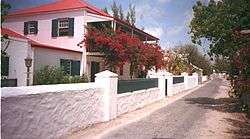
The Turks and Caicos Islands are a British Overseas Territory.[4] As a British territory, its sovereign is Queen Elizabeth II of the United Kingdom, represented by a governor appointed by the monarch, on the advice of the Foreign Office.[4] With the election of the territory's first Chief Minister, J. A. G. S. McCartney, the islands first adopted a constitution on 30 August 1976. The national holiday, Constitution Day, is celebrated annually on 30 August.[42]
The territory's legal system is based on English common law, with a small number of laws adopted from Jamaica and the Bahamas. Suffrage is universal for those over 18 years of age. English is the official language. Grand Turk is the administrative and political capital of the Turks and Caicos Islands and Cockburn Town has been the seat of government since 1766.
The Turks and Caicos Islands participate in the Caribbean Development Bank, is an associate in CARICOM, member of the Universal Postal Union and maintains an Interpol sub-bureau. The United Nations Special Committee on Decolonization includes the territory on the United Nations list of Non-Self-Governing Territories.
Under the new Constitution that came into effect in October 2012, legislative power is held by a unicameral House of Assembly, consisting of 19 seats, 15 elected and four appointed by the governor; of elected members, five are elected at large and 10 from single-member districts for four-year terms.[4]
In the 2016 elections the People's Democratic Movement prevailed and Sharlene Cartwright-Robinson became Premier.[32]
Administrative divisions
The Turks and Caicos Islands are divided into six administrative districts (two in the Turks Islands and four in the Caicos Islands), headed by district commissioners. For the House of Assembly, the Turks and Caicos Islands are divided into 15 electoral districts (four in the Turks Islands and eleven in the Caicos Islands).
Judiciary
The judicial branch of government is headed by a Supreme Court; appeals are heard by the Court of Appeal and final appeals by the United Kingdom's Judicial Committee of the Privy Council.[4] There are three justices of the Supreme Court, a Chief Justice and two others. The Court of Appeal consists of a president and at least two justices of appeal.
Magistrates' Courts are the lower courts and appeals from Magistrates' Courts are sent to the Supreme Court.
As of September 2014, the Chief Justice is Justice Margaret Ramsay-Hale.[43]
- Chief Justices
- John Charles Powell Fieldsend 1985–1987
- Sir Frederick Smith 1987–1990
- Lindsey Worrall 1990–1993
- Kipling Douglas 1993–1996
- Sir Richard Ground 1998–2004
- Christopher Gardner 2004–2007
- Sir Gordon Ward 2008–2012
- Edwin Goldsbrough 2012–2014
- Margaret Ramsey Hale 2014–present
Military
As a British Overseas Territory, the defence of the Turks and Caicos is the responsibility of the United Kingdom.[4]
Governor Nigel Dakin announced in early December 2019 that the Turks and Caicos will build its own defence regiment, the Turks and Caicos Regiment, with the assistance of the UK's Ministry of Defence and it is to be similar to the Bermuda Regiment and the Cayman Regiment. The Turks and Caicos Regiment, like the Bermuda Regiment and the Cayman Regiment, will focus on increasing the nation's security, and, in times of natural disasters, the Regiment would be trained in engineering and communications. In mid December 2019, a team from the UK's Ministry of Defence was on Turks and Caicos to start on building the Regiment. It is projected that the Turk and Caicos Regiment will go operational sometime within the third quarter of 2020, putting it nearly half a year after the Cayman Regiment.[44]
In spring 2020, a Security and Assistance Team from the United Kingdom Ministry of Defence arrived in Turks and Caicos to assist with the COVID-19 pandemic, the 2020 Atlantic hurricane season, and to help build the new Turks and Caicos Regiment.[45]
In early June 2020, Lieutenant Colonel Ennis Grant was appointed as the commanding officer of the new Turks and Caicos Regiment.[46]
Further recruitment of Senior personnel into the new Turks and Caicos Regiment took place from mid-late Jun through early July 2020. This includes a second-in-command, two junior officers or troop commanders, a warrant officer class 1 or regimental sergeant major, and a warrant officer class 2 or chief clerk. A further recruitment of an additional 40 personnel is expected further down in 2020.
Population
| Year | Pop. | ±% |
|---|---|---|
| 1911 | 5,615 | — |
| 1921 | 5,522 | −1.7% |
| 1943 | 6,138 | +11.2% |
| 1960 | 5,668 | −7.7% |
| 1970 | 5,558 | −1.9% |
| 1980 | 7,413 | +33.4% |
| 1990 | 11,465 | +54.7% |
| 2000 | 20,014 | +74.6% |
| 2012 | 31,458 | +57.2% |
| Sources:[47][48] | ||
Demographics
Eight of the thirty islands in the territory are inhabited, with a total population estimated from preliminary results of the census of 25 January 2012 (released on 12 August 2012) of 31,458 inhabitants, an increase of 58.2% from the population of 19,886 reported in the 2001 census.[3] July 2018 estimates put the population at 53,700.[4] One-third of the population is under 15 years old, and only 4% are 65 or older. In 2000 the population was growing at a rate of 3.55% per year. The infant mortality rate was 18.66 deaths per 1,000 live births and the life expectancy at birth was 73.28 years (71.15 years for males, 75.51 years for females). The total fertility rate was 3.25 children born per woman. The annual population growth rate is 2.82%.
The CIA World Factbook breaks down the islanders' ethnicity as African 87%, European 7.9%, Mixed 2.5.%, East Indian 1.3% and Other 0.7%.[4] There is a small Haitian community on the islands.[4][13]
Vital statistics
Vital statistics related to the population are:[49][50][51]
| Average population (x 1000) | Live births | Deaths | Natural change | Crude birth rate (per 1000) | Crude death rate (per 1000) | Natural change (per 1000) | |
|---|---|---|---|---|---|---|---|
| 1950 | 5.0 | 240 | 80 | 160 | 47.6 | 15.9 | 31.7 |
| 1951 | 5.0 | 239 | 71 | 168 | 48.0 | 14.2 | 33.7 |
| 1952 | 5.0 | 243 | 79 | 164 | 48.8 | 15.9 | 33.0 |
| 1953 | 5.0 | 206 | 92 | 114 | 41.1 | 18.3 | 22.7 |
| 1954 | 5.1 | 238 | 74 | 164 | 46.7 | 14.5 | 32.2 |
| 1955 | 5.2 | 268 | 96 | 172 | 51.6 | 18.5 | 33.1 |
| 1956 | 5.3 | 223 | 83 | 140 | 41.9 | 15.6 | 26.3 |
| 1957 | 5.4 | 231 | 75 | 156 | 42.4 | 13.8 | 28.7 |
| 1958 | 5.6 | 244 | 84 | 160 | 43.9 | 15.1 | 28.8 |
| 1959 | 5.7 | 244 | 90 | 154 | 43.1 | 15.9 | 27.2 |
| 1960 | 5.7 | 252 | 60 | 192 | 44.0 | 10.5 | 33.5 |
| 1961 | 5.8 | 247 | 65 | 182 | 42.9 | 11.3 | 31.6 |
| 1962 | 5.8 | 252 | 69 | 183 | 43.7 | 12.0 | 31.8 |
| 1963 | 5.7 | 238 | 74 | 164 | 41.5 | 12.9 | 28.6 |
| 1964 | 5.7 | 217 | 61 | 156 | 38.0 | 10.7 | 27.3 |
| 1965 | 5.7 | 149 | 66 | 83 | 26.3 | 11.6 | 14.6 |
| 1966 | 5.6 | 199 | 63 | 136 | 35.4 | 11.2 | 24.2 |
| 1967 | 5.6 | 137 | 27 | 110 | 24.5 | 4.8 | 19.7 |
| 1968 | 5.6 | 163 | 38 | 125 | 29.3 | 6.8 | 22.5 |
| 1969 | 5.6 | 162 | 50 | 112 | 29.1 | 9.0 | 20.1 |
| 1970 | 5.6 | 176 | 47 | 129 | 31.3 | 8.3 | 22.9 |
| 1971 | 5.8 | 190 | 59 | 131 | 33.0 | 10.3 | 22.8 |
| 1972 | 5.9 | 171 | 46 | 125 | 28.9 | 7.8 | 21.1 |
| 1973 | 6.1 | 191 | 46 | 145 | 31.1 | 7.5 | 23.6 |
| 1974 | 6.3 | 152 | 36 | 116 | 24.0 | 5.7 | 18.3 |
| 1975 | 6.5 | 159 | 54 | 105 | 24.3 | 8.2 | 16.0 |
| 1976 | 6.7 | 200 | 43 | 157 | 29.7 | 6.4 | 23.4 |
| 1977 | 6.9 | 194 | 47 | 147 | 28.2 | 6.8 | 21.3 |
| 1978 | 7.1 | 170 | 51 | 119 | 24.1 | 7.2 | 16.9 |
| 1979 | 7.3 | 197 | 28 | 169 | 27.1 | 3.9 | 23.3 |
| 1980 | 7.5 | 214 | 15 | 199 | 28.4 | 2.0 | 26.4 |
| 1981 | 7.9 | 189 | 24 | 165 | 24.1 | 3.1 | 21.0 |
| 1982 | 8.2 | 204 | 33 | 171 | 24.7 | 4.0 | 20.7 |
| 1983 | 8.7 | ||||||
| 1984 | 9.1 | ||||||
| 1985 | 9.5 | ||||||
| 1986 | 9.9 | ||||||
| 1987 | 10.2 | ||||||
| 1988 | 10.6 | ||||||
| 1989 | 11.0 | ||||||
| 1990 | 11.6 | 240 | 50 | 190 | 20.8 | 4.3 | 16.5 |
| 1991 | 12.2 | 211 | 59 | 152 | 17.3 | 4.8 | 12.5 |
| 1992 | 13.0 | 263 | 52 | 211 | 20.3 | 4.0 | 16.3 |
| 1993 | 13.8 | 197 | 66 | 131 | 14.3 | 4.8 | 9.5 |
| 1994 | 14.6 | 229 | 62 | 167 | 15.7 | 4.2 | 11.4 |
| 1995 | 15.3 | 300 | 74 | 226 | 19.6 | 4.8 | 14.7 |
| 1996 | 16.0 | 324 | 55 | 269 | 20.3 | 3.4 | 16.8 |
| 1997 | 16.5 | 287 | 55 | 232 | 17.4 | 3.3 | 14.0 |
| 1998 | 17.1 | 272 | 24 | 248 | 15.9 | 1.4 | 14.5 |
| 1999 | 17.9 | 292 | 39 | 253 | 16.3 | 2.2 | 14.2 |
| 2000 | 18.9 | 290 | 67 | 223 | 15.4 | 3.5 | 11.8 |
| 2001 | 20.2 | 271 | 69 | 202 | 13.4 | 3.4 | 10.0 |
| 2002 | 21.7 | 153 | 48 | 105 | 7.0 | 2.2 | 4.8 |
| 2003 | 23.4 | 213 | 61 | 152 | 9.1 | 2.6 | 6.5 |
| 2004 | 25.0 | 300 | 46 | 254 | 12.0 | 1.8 | 10.1 |
| 2005 | 30.6 | 318 | 53 | 265 | 10.4 | 1.7 | 8.7 |
| 2006 | 33.2 | 411 | 73 | 338 | 12.3 | 2.3 | 10.0 |
| 2007 | 34.9 | 462 | 116 | 346 | 13.1 | 3.3 | 9.8 |
| 2008 | 36.6 | 460 | 65 | 395 | 12.4 | 1.8 | 10.6 |
| 2009 | 36 | 73 | |||||
| 2010 | 34.3 | 116 | 14.8 | 2.3 | |||
| 2011 | 31.5 |
Population breakdown
| Island | Capital | Area (km²) | Population[lower-alpha 2] | |||||
|---|---|---|---|---|---|---|---|---|
| Caicos Islands | ||||||||
| South Caicos | Cockburn Harbour | 21.2 | 2,013 | |||||
| West Caicos | New Marina | 28 | 10 (Employees of new resort) | |||||
| Providenciales | Downtown Providenciales | 122 | 33,253 | |||||
| Pine Cay | South Bay Village | 3.2 | 30 (Resort Staff) | |||||
| Parrot Cay | Parrot Cay Village | 5 | 90 (Half resort staff, half residential) | |||||
| North Caicos | Bottle Creek | 116.4 | 2,066 | |||||
| Middle Caicos | Conch Bar | 136 | 522 | |||||
| Ambergris Cays | Big Ambergris Cay | 10.9 | 50 | |||||
| Other Caicos Islands | East Caicos | 146.5 | 0 | |||||
| Turks Islands | ||||||||
| Grand Turk | Cockburn Town | 17.6 | 8,051 | |||||
| Salt Cay | Balfour Town | 7.1 | 315 | |||||
| Other Turks Islands | Cotton Cay | 2.4 | 0 | |||||
| Turks and Caicos Islands | Cockburn Town | 616.3 | 49000[6] | |||||
Language
The official language of the islands is English, but the population also speaks Turks and Caicos Islands Creole,[52] which is similar to Bahamian Creole.[53] Due to its proximity to Cuba and Hispaniola, large Haitian Creole and Spanish-speaking communities have developed in the territory due to immigration, both legal and illegal, from Creole-speaking Haiti and from Spanish-speaking Cuba and Dominican Republic.[54]

Religion
86% of the population of Turks and Caicos are Christian (Baptists 35.8%, Church of God 11.7%, Roman Catholics 11.4%, Anglicans 10%, Methodists 9.3%, Seventh-day Adventists 6%, Jehovah's Witnesses 1.8%), with other faiths making up the remaining 14%.[4]
Catholics are served by the Mission "Sui Iuris" for Turks and Caicos, which was erected in 1984 with territory taken from the then Diocese of Nassau.
Culture
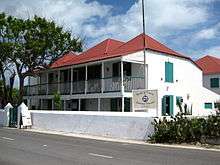
The Turks and Caicos Islands are perhaps best known musically for ripsaw music, a genre which originated on the islands.[55] The Turks and Caicos Islands are known for their annual Music and Cultural Festival showcasing many local talents and other dynamic performances by many music celebrities from around the Caribbean and United States.
Women continue traditional crafts of using a straw to make baskets and hats on the larger Caicos islands. It is possible that this continued tradition is related to the liberated Africans who joined the population directly from Africa in the 1830s and 1841 from shipwrecked slavers; they brought cultural craft skills with them.[25]
The island's most popular sports are fishing, sailing, football (soccer) and cricket (which is the national sport).
Turks and Caicos cuisine is based primarily around seafood, especially conch.[56] Two common dishes, whilst not traditionally 'local', are conch fritters and conch salad.[57]
Citizenship
Because the Turks and Caicos is a British Overseas Territory and not an independent country, they at one time could not confer citizenship. Instead, people with close ties to Britain's Overseas Territories all held the same nationality: British Overseas Territories Citizen (BOTC) as defined by the British Nationality Act 1981 and subsequent amendments. BOTC, however, does not confer any right to live in any British Overseas Territory, including the territory from which it is derived; instead, the rights normally associated with citizenship derive from what is called Belonger status and island natives or those descended from natives are said to be Belongers.
In 2002, the British Overseas Territories Act restored full British citizenship status to all citizens of British Overseas Territories, including the Turks and Caicos.
Education
The Ministry of Health, Education, Youth, Sports, and Women's Affairs oversees education in Turks and Caicos. Public education is supported by taxation and is mandatory for children aged five to sixteen. Primary education lasts for six years and secondary education lasts for five years. In the 1990s the Primary In-Service Teacher Education Project (PINSTEP) was launched in an effort to increase the skills of its primary school teachers, nearly one-quarter of whom were unqualified. Turks and Caicos also worked to refurbish its primary schools, reduce textbook costs, and increase equipment and supplies given to schools. For example, in September 1993, each primary school was given enough books to allow teachers to establish in-class libraries. In 2001, the student-teacher ratio at the primary level was roughly 15:1.
Public secondary schools include:[58]
- HJ Robinson High School (Grand Turk)
- Clement Howell High School (Providenciales)
- Long Bay High School (Providenciales)
- Raymond Gardiner High School (North Caicos)
- Marjorie Basden High School (South Caicos)
International School of the Turks and Caicos Islands, a private school which serves preschool through grade six, is in Leeward, Providenciales. In 2014 it had 106 students. It was known as The Ashcroft School until 2014.[59]
The Turks and Caicos Islands Community College offers free higher education to students who have successfully completed their secondary education. The community college also oversees an adult literacy program. Once a student completes their education at Turks and Caicos Islands Community College, they are allowed to further their education at a university in the United States, Canada, or the United Kingdom for free. They have to commit to working in The Turks and Caicos Islands for four years to receive this additional education.
The public University of the West Indies Open Campus has one site in the territory.[60] Charisma University [61] is a private and non-profit university that also provides higher education in Turks & Caicos Islands.
Health system
The Turks and Caicos established a National Health Insurance Plan in 2010.[62] Residents contribute to a National Health Insurance Plan through salary deduction and nominal user fees. Majority of care is provided by the private-public-partnership hospitals on Providenciales and Grand Turk. In addition, there are a number of government clinics and private clinics. The hospital opened in 2010 is administered by Interhealth Canada and has been accredited by Accreditation Canada in 2012 and 2015.
Economy
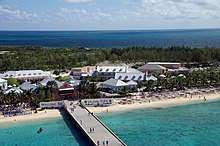
The economy of Turks and Caicos is dominated by tourism, offshore finance and fishing.[4][13] The US dollar is the main currency used on the islands.
Historically the salt industry, along with small sponge and hemp exports, sustained the Turks and Caicos Islands (only barely, however; there was little population growth and the economy stagnated). The economy grew in the 1960s, when American investors arrived on the islands and funded the construction of an airstrip on Providenciales and built the archipelago's first hotel, "The Third Turtle". A small trickle of tourists began to arrive, supplementing the salt-based economy. Club Med set up a resort at Grace Bay soon after. In the 1980s, Club Med funded an upgrading of the airstrip to allow for larger aircraft, and since then, tourism has been gradually on the increase.[13]
In 2009, GDP contributions were as follows:[63] Hotels & Restaurants 34.67%, Financial Services 13.12%, Construction 7.83%, Transport, Storage & Communication 9.90%, and Real Estate, Renting & Business Activities 9.56%. Most capital goods and food for domestic consumption are imported.[4]
In 2010/2011, major sources of government revenue included Import Duties (43.31%), Stamp Duty on Land Transaction (8.82%), Work Permits and Residency Fees (10.03%) and Accommodation Tax (24.95%). The territory's gross domestic product as of late 2009 is approximately US$795 million (per capita $24,273).[63]
The labour force totalled 27,595 workers in 2008. The labour force distribution in 2006 is as follows:
| Skill level | Percentage |
|---|---|
| Unskilled/Manual | 53% |
| Semi-skilled | 12% |
| Skilled | 20% |
| Professional | 15% |
The unemployment rate in 2008 was 8.3%. In 2007–2008, the territory took in revenues of $206.79 million against expenditures of $235.85 million. In 1995, the island received economic aid worth $5.7 million. The territory's currency is the United States dollar, with a few government fines (such as airport infractions) being payable in pounds sterling. Most commemorative coin issues are denominated in crowns.[64]
The primary agricultural products include limited amounts of maize, beans, cassava (tapioca) and citrus fruits. Fish and conch are the only significant export, with some $169.2 million of lobster, dried and fresh conch, and conch shells exported in 2000, primarily to the United Kingdom and the United States. In recent years, however, the catch has been declining. The territory used to be an important trans-shipment point for South American narcotics destined for the United States, but due to the ongoing pressure of a combined American, Bahamian and Turks and Caicos effort this trade has been greatly reduced.
The islands import food and beverages, tobacco, clothing, manufacture and construction materials, primarily from the United States and the United Kingdom. Imports totalled $581 million in 2007.
The islands produce and consume about 5 GWh of electricity, per year, all of which comes from fossil fuels.
Tourism
Tourism is one of the largest sources of income for the islands, with most visitors coming from America via ship.[4] Tourist arrivals had risen to 264,887 in 2007 and to 351,498 by 2009. In 2010, a total of 245 cruise ships arrived at the Grand Turk Cruise Terminal, carrying a total of 617,863 visitors.[65]
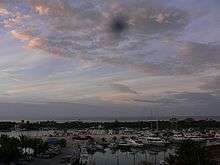
The government is pursuing a two-pronged strategy to increase tourism. Upscale resorts are aimed at the wealthy, while a large new cruise ship port and recreation centre has been built for the masses visiting Grand Turk. Turks and Caicos Islands has one of the longest coral reefs in the world[66][67] and the world's only conch farm.[68]
The French vacation village company of Club Méditerannée (Club Med) has an all-inclusive adult resort called 'Turkoise' on one of the main islands.
The islands have become popular with various celebrities. Several Hollywood stars have owned homes in the Turks and Caicos, including Dick Clark[69] and Bruce Willis.[70] Ben Affleck and Jennifer Garner married on Parrot Cay in 2005. Actress Eva Longoria and her ex-husband Tony Parker went to the islands for their honeymoon in July 2007 and High School Musical actors Zac Efron and Vanessa Hudgens went for a vacation there. In 2013 Hollywood writer/director Rob Margolies and actress Kristen Ruhlin vacationed here. Musician Nile Rodgers has a vacation home on the island.
To boost tourism during the Caribbean low season of late summer, since 2003 the Turks and Caicos Tourist Board have organised and hosted an annual series of concerts during this season called the Turks & Caicos Music and Cultural Festival.[71] Held in a temporary bandshell at The Turtle Cove Marina in The Bight on Providenciales, this festival lasts about a week and has featured several notable international recording artists, such as Lionel Richie, LL Cool J, Anita Baker, Billy Ocean, Alicia Keys, John Legend, Kenny Rogers, Michael Bolton, Ludacris, Chaka Khan, and Boyz II Men.[72] More than 10,000 people attend annually.[72]
- Resorts
Biodiversity

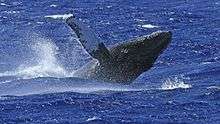
The Turks and Caicos Islands are a biodiversity hotspot. The islands have many endemic species and others of international importance, due to the conditions created by the oldest established salt-pan development in the Caribbean. The variety of species includes a number of endemic species of lizards, snakes, insects and plants, and marine organisms; in addition to being an important breeding area for seabirds.[79]
The UK and Turks and Caicos Islands Governments have joint responsibility for the conservation and preservation to meet obligations under international environmental conventions.[80]
Due to this significance, the islands are on the United Kingdom's tentative list for future UNESCO World Heritage Sites.[81]
Transportation
Providenciales International Airport is the main entry point for the Turks and Caicos Islands, with JAGS McCartney International Airport serving the capital Cockburn Town on Grand Turk Island. Altogether, there are seven airports, located on each of the inhabited islands. Five have paved runways (three of which are approximately 2,000 m (6,600 ft) long and one is approximately 1,000 m (3,300 ft) long), and the remaining two have unpaved runways (one of which is approximately 1,000 m (3,300 ft) long and the other is significantly shorter).[82]
The islands have 121 kilometres (75 miles) of highway, 24 km (15 mi) paved and 97 km (60 mi) unpaved. Like the United States Virgin Islands and British Virgin Islands, the Turks and Caicos Islands drive on the left.[83]
The territory's main international ports and harbours are on Grand Turk and Providenciales.[84]
The islands have no significant railways. In the early twentieth century East Caicos operated a horse-drawn railway to transport sisal from the plantation to the port. The 14-kilometre (8.7-mile) route was removed after sisal trading ceased.[85]
Spaceflight
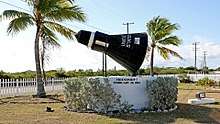
From 1950 to 1981, the United States had a missile tracking station on Grand Turk. In the early days of the American space program, NASA used it. After his three earth orbits in 1962, American astronaut John Glenn successfully landed in the nearby ocean and was brought back ashore to Grand Turk island.[86][87]
Postal system
There is no postal delivery in the Turks and Caicos; mail is picked up at one of four post offices on each of the major islands.[88] Mail is transported three or seven times a week, depending on the destination.[89] The Post Office is part of the territory's government and reports to the Minister of Government Support Services.[90]
Media
Mobile phone service is provided by Cable & Wireless Communications, through its Flow brand, using GSM 850 and TDMA, and Digicel, using GSM 900 and 1900 and Islandcom Wireless, using 3G 850. Cable & Wireless provides CDMA mobile phone service in Providenciales and Grand Turk. The system is connected to the mainland by two submarine cables and an Intelsat earth station. There were three AM radio stations (one inactive) and six FM stations (no shortwave) in 1998. The most popular station is Power 92.5 FM which plays Top 100 hits. Over 8000 radio receivers are owned across the territory.
West Indies Video (WIV) has been the sole cable television provider for the Turks and Caicos Islands for over two decades and WIV4 (a subsidiary of WIV) has been the only broadcast station in the islands for over 15 years; broadcasts from the Bahamas can also be received. The territory has two internet service providers and its country code top-level domain (ccTLD) is ".tc". Amateur radio callsigns begin with "VP5" and visiting operators frequently work from the islands.
WIV introduced Channel 4 News in 2002 broadcasting local news and infotainment programs across the country. Channel 4 was re-launched as WIV4 in November 2007.
Since 2013 4NEWS has become the Islands first HD Cable News service with Television Studios in Grace Bay, Providenciales. DigicelPlay is the local cable provider.
Turks and Caicos's newspapers include the Turks and Caicos Weekly News, the Turks and Caicos SUN[91] and the Turks and Caicos Free Press.[92] All three publications are weekly. The Weekly News and the Sun both have supplement magazines. Other local magazines Times of the Islands,[93] s3 Magazine,[94] Real Life Magazine, Baller Magazine, and Unleashed Magazine.
Sports
Cricket is the islands' national sport.[95] The national team takes part in regional tournaments in the ICC Americas Championship,[96] as well as having played one Twenty20 match as part of the 2008 Standford 20/20.[97] Two domestic leagues exist, one on Grand Turk with three teams and another on Providenciales.[95]
As of 4 July 2012, Turks and Caicos Islands' football team shared the position of the lowest ranking national men's football team in the world at the rank of 207th.[98]
Because the territory is not recognized by the International Olympic Committee, Turks and Caicos Islanders compete for Great Britain at the Olympic Games.[99]
Notable people
Sports
- Christopher Bryan (born 1960 in the Turks and Caicos Islands) is a former association football player. In 2006 he became the President of the Turks and Caicos Islands Football Association
- Errion Charles (born 1965 in Saint Vincent) is a sportsman from the Turks and Caicos Islands who has represented his nation at both association football and cricket
- Gregory Watts (born 1967 in the Turks and Caicos Islands) is a former footballer, he played as a defender
- Gavin Glinton (born 1979 in Grand Turk) is a footballer who last played for Nam Dinh FC
- Trevor Ariza (born 1985 in Miami) is an American professional basketball player for the Phoenix Suns. He is of Turks & Caicos Islands and Dominican descent through his parents, Lolita Ariza and Trevor Saunders of Grand Turk
- Delano Williams (born 1993 in Grand Turk) is a British sprinter. He trains with the Racers Track Club in Jamaica
Politics
- Nathaniel Francis (1912 – 2004 both in the Turks and Caicos Islands) was a politician who served as the island territory's acting Chief Minister from 28 March 1985 until 25 July 1986, when he was forced to resign after charges of corruption and patronage were leveled against him
- Clement Howell (1935 in Blue Hills, Providenciales – 1987 near Nassau, Bahamas) was a politician who served on a four-member interim Advisory Council beginning in July 1986
- Norman B. Saunders (born 1943 in the Turks and Caicos Islands) is a former politician who served as the island territory's Chief Minister until March 1985, when he was arrested in Miami. In July 1985 he was sentenced to eight years in prison on conspiracy charges related to drug smuggling.
- James Alexander George Smith McCartney (1945 in Grand Turk – 1980 in New Jersey) also known as "Jags" McCartney was a politician who served as the island territory's first Chief Minister from August 1976 until 9 May 1980, when he died in a plane crash over New Jersey.
- Washington Misick (born 1950 in the Turks and Caicos Islands) is a politician who served as the island territory's Chief Minister from April 1991 to 31 January 1995.
- Ariel Misick (born 1951) is a former minister of development and commerce. He served on a four-member interim Advisory Council from July 1986 to 3 March 1988
- Oswald Skippings (born 1953 in the Turks and Caicos Islands) is a politician who served as the island territory's Chief Minister from 19 June 1980 to November 1980 and again from 3 March 1988 to April 1991.
- Michael Misick (born 1966 in Bottle Creek, North Caicos) is the former chief minister from 15 August 2003 to 9 August 2006 and was the first Premier from 9 August 2006 to 23 March 2009. He is on trial for conspiracy to receive bribes, conspiracy to defraud the government and money laundering.
See also
- Index of Turks and Caicos Islands-related articles
- Outline of the Turks and Caicos Islands
Notes
- Alternative sources give different figures for the area of the Islands. The CIA World Factbook gives 430 km2 (170 sq mi),[6] the European Union says 417 km2 (161 sq mi),[7] and the Encyclopædia Britannica says "Area at high tide, 238 square miles (616 square km); at low tide, 366 square miles (948 square km)".[8] A report by the Turks and Caicos Islands Department of Economic Planning and Statistics gives the same numbers as the Encyclopædia Britannica though its definitions are less clear.[9]
- Area and population data retrieved from the 2012 census.
References
- "Turks and Caicos Islands –". Nationalanthems.info. May 2013. Retrieved 22 March 2017.
- "Statistics Department | Government of the Turks and Caicos Islands". www.gov.tc.
- "Census Figures from Turks and Caicos Strategic Planning and Policy Department Website". Sppdtci.com. Retrieved 22 March 2017.
- "CIA World Factbook- Turks and Caicos Islands". Retrieved 19 July 2019.
- "Encyclopedia Britannica - Turks and Caicos Islands". Retrieved 20 July 2019.
- "Turks and Caicos Islands". CIA World Factbook. Retrieved 13 March 2013.
- "International Cooperation and Development - International Cooperation and Development - European Commission". Archived from the original on 28 September 2008. Retrieved 11 December 2008.
- "Turks and Caicos Islands". Encyclopædia Britannica. Retrieved 13 March 2013.
- "Archived copy" (PDF). Archived from the original (PDF) on 25 July 2011. Retrieved 13 March 2013.CS1 maint: archived copy as title (link)
- "World Directory of Minorities and Indigenous Peoples – Turks and Caicos Islands: Overview". Minority Rights Group International, 2007.
- Unknown. "Turks and Caicos – History". Geographia.com. Retrieved 22 March 2017.
- "Turks and Caicos". Turksandcaicostourism.com. 24 January 2013. Retrieved 22 March 2017.
- "Encyclopedia Britannica- Turks and Caicos Islands". Retrieved 20 July 2019.
- "Encomienda or Slavery? The Spanish Crown's Choice of Labor Organization in Sixteenth-Century Spanish America" (PDF), Latin American Studies.
- Paul Albury (1975). The Story of the Bahamas. MacMillan Caribbean. ISBN 0-333-17131-4 pp. 34–37
- Michael Craton (1986). A History of the Bahamas. San Salvador Press. ISBN 0-9692568-0-9 pp. 17, 37–39
- Julian Granberry and Gary S. Vescelius. (2004) Languages of the Pre-Columbian Antilles. The University of Alabama Press. ISBN 0-8173-5123-X pp. 80–86
- William F. Keegan (1992). The People Who Discovered Columbus: The Prehistory of the Bahamas. University Press of Florida. ISBN 0-8130-1137-X pp. 25, 48–62, 86, 170–173, 212–213, 220–223
- Carl Ortwin Sauer. (1966, Fourth printing, 1992) The Early Spanish Main. University of California Press. ISBN 0-520-01415-4 pp. 159–160, 191
- "Timeline of the History of the Turks and Caicos Islands (TCI Museum)". Retrieved 20 July 2019.
- "Unnoticed Unrest in Turks and Caicos and the Canadian Connection". GeoCurrents. Retrieved 23 January 2017.
- Leshikar-Denton, Margaret E; Erreguerena, Pilar Luna (15 October 2008). Underwater and Maritime Archaeology in Latin America and the Caribbean. p. 209. ISBN 9781598742626. Retrieved 22 March 2017.
- Jane Sutton, "Shipwreck may hold key to Turks and Caicos' lineage", Reuters, 26 November 2008
- Randolph E. Schmid, "Artifacts appear linked to Trouvadore", Associated Press, 25 November 2008.
- Nigel Sadler, "The Sinking of the Slave Ship Trouvadore: Linking the Past to the Present", Underwater and Maritime Archaeology in Latin America and the Caribbean, edited by Margaret E Leshikar-Denton, Pilar Luna Erreguerena, Left Coast Press, 2008
- Kersell, John E. (1988). "Government administration in a very small microstate: Developing the Turks and Caicos Islands". Public Administration and Development. 8 (2): 169–181. doi:10.1002/pad.4230080206.
- "Central America :: Turks and Caicos Islands — The World Factbook - Central Intelligence Agency". www.cia.gov. Retrieved 24 April 2019.
- "The Montreal Gazette - Google News Archive Search". news.google.com.
- Griffith, Ivelaw L. (1 May 1997). "Illicit Arms Trafficking, Corruption, and Governance in the Caribbean". Penn State International Law Review. 15 (3). pp. 495–6.
- "A major step in clean up of public life in Turks and Caicos". Foreign Office of the United Kingdom. 14 August 2009. Archived from the original on 10 October 2012.
- Clegg, Peter (2013). "The United Kingdom and its caribbean overseas territories: Present relations and future prospects" (PDF). Caribbean Journal of International Relations & Diplomacy. 1 (2): 53–64, page 56. Archived (PDF) from the original on 31 January 2017.
- "Turks and Caicos: Where women hold the top jobs". BBC News. 29 January 2017.
- "Turks and Caicos In Numbers". Beach House TCI. Retrieved 1 August 2015.
- "STS-100 Shuttle Mission Imagery". Spaceflight.nasa.gov. 1 May 2001. Retrieved 31 July 2011.
- "Dep | Fafsa | Postal Service | Socialsecurity.Gov | Passport | Fafsa.Ed.Gov at Depstc.org" (PDF). 25 July 2011. Archived from the original on 25 July 2011. Retrieved 22 March 2017.CS1 maint: BOT: original-url status unknown (link)
- "Historical Fisheries Production And Trade of the Turks And Caicos Island" (PDF). Seaaroundus.org. Archived from the original (PDF) on 16 August 2011. Retrieved 31 July 2011.
- "Turks Caicos Bank Website » Mouchoir Bank". Turkscaicosbank.com. 11 April 2008. Retrieved 31 July 2011.
- "Frequently Asked Questions". Aquamarine Concierge. Retrieved 11 April 2020.
- "Turks and Caicos, CIA – The world factbook". Cia.gov.
- "Grand Turk, Turks And Caicos Islands Monthly Weather". Weather.com. Archived from the original on 12 June 2018. Retrieved 22 March 2017.
- "Grand Turk, Turks and Caicos Islands Travel Weather Averages". Weatherbase. Retrieved 22 March 2017.
- "Turks and Caicos Islands – Constitution Day (National Day)". www.flaginstitute.org. Retrieved 6 August 2018.
- "Monday, September 22, 2014– Daughter of eminent Jamaican lawyer Ian Ramsay sworn in as chief justice of Turks & Caicos". Jamaica Observer. Archived from the original on 14 September 2015. Retrieved 22 October 2015.
- "TCI to build its own military regiment". tcweeklynews.com.
- "Arrival Of A Security Assistance Team In TCI From The Uk, – Welcome to the Turks and Caicos Islands".
- "TCI Regiment gets its first commanding officer". tcweeklynews.com.
- "Internet Archive Wayback Machine". Archived from the original on 6 May 2013. Retrieved 22 March 2017.
- "Internet Archive Wayback Machine". Archived from the original on 16 October 2015. Retrieved 22 March 2017.
- "United Nations Statistics Division – Demographic and Social Statistics". Unstats.un.org. Retrieved 22 March 2017.
- "Archived copy". Archived from the original on 13 November 2013. Retrieved 2 January 2014.CS1 maint: archived copy as title (link)
- "Archived copy" (PDF). Archived from the original (PDF) on 28 March 2016. Retrieved 18 March 2016.CS1 maint: archived copy as title (link)
- Ethnologue report on Languages of Turks and Caicos Islands
- "Turks and Caicos Creole English". Ethnologue. Retrieved 22 March 2017.
- "Turks and Caicos Islands". Ethnologue. Retrieved 22 March 2017.
- Annalisa Rellie; Tricia Hayne (2008). Turks & Caicos Islands: The Bradt Travel Guide. Bradt Travel Guides. p. 34. ISBN 978-1-84162-268-2.
- "The Food and Cuisine of Turks and Caicos". Thesandstc.com. 2 December 2015. Retrieved 22 March 2017.
- "Cuisine of the Turks and Caicos Islands". Archived from the original on 16 July 2011. Retrieved 14 July 2011.
- "Government". Government of the Turks and Caicos. Retrieved 19 January 2020.
- Tyson, Vivian (15 September 2014). "ASHCROFT SCHOOL IS NOW INTERNATIONAL SCHOOL OF THE TCI". The Sun. Retrieved 18 January 2020.
- "The Open Campus in Turks & Caicos | Open Campus".
- "Charisma University | Critical Thinking on Global Scale". charisma.edu.eu.
- "Turks and Caicos Islands". Retrieved 9 October 2019.
- "Archived copy". Archived from the original on 13 September 2014. Retrieved 13 July 2014.CS1 maint: archived copy as title (link)
- Coins from Turks and Caicos Islands Numista (en.numista.com). Retrieved on 2019-08-22.
- "Archived copy". Archived from the original on 13 November 2009. Retrieved 15 August 2009.CS1 maint: archived copy as title (link)
- "The World's Third-Largest Coral System Awaits At Turks And Caicos". Jupiter Magazine. Retrieved 12 August 2019.
- "Interesting Facts about the Turks and Caicos Islands". Archived from the original on 5 April 2016. Retrieved 14 September 2016.
- "Tourism in Turks & Caicos". Caribbean Days. Retrieved 20 February 2015.
- "Celebrities and Famous People in the Turks and Caicos". Visit Turks and Caicos Islands. Retrieved 10 October 2019.
- Clarke, Katherine. "Bruce Willis Sells Turks and Caicos Compound for $27 Million". WSJ. Retrieved 10 October 2019.
- "The Turks and Caicos Music & Cultural Festival". 21 April 2008. Archived from the original on 12 June 2008. Retrieved 7 August 2008.
- "The Turks and Caicos Music & Cultural Festival News Release". 21 April 2008. Archived from the original on 4 August 2008. Retrieved 7 August 2008.
- "Grace Bay Club, a Turks and Caicos resort and Caribbean spa". Gracebayresorts.com. Retrieved 22 March 2017.
- "Turks & Caicos luxury resort, The Somerset on Grace Bay". Thesomerset.com. Retrieved 22 March 2017.
- "Turks and Caicos All Inclusive Family Resort – Beaches Turks & Caicos Resort Villages & Spa". All Inclusive Resorts and Caribbean Vacations for the Whole Family – Beaches Caribbean Family Resorts. Retrieved 11 June 2015.
- "Turks and Caicos Resort – Seven Stars Grace Bay Hotel". Sevenstarsgracebay.com. Retrieved 22 March 2017.
- "The Best Value of all the Turks and Caicos Resorts". Alexandra Resort. Retrieved 11 June 2015.
- "Turks and Caicos Resort, Luxury Caribbean Beach Resort | Turks and Caicos Resort, Luxury Caribbean Beach Resort". Thewestbayclub.com. Archived from the original on 9 July 2017. Retrieved 22 March 2017.
- "Science: UK Overseas Territories – Turks and Caicos Islands". Kew. Archived from the original on 8 November 2012. Retrieved 29 December 2012.
- "Science: UK Overseas Territories: Biodiversity". Kew. Archived from the original on 2 May 2013. Retrieved 29 December 2012.
- "Turks and Caicos Islands – UNESCO World Heritage Centre". Whc.unesco.org. 27 January 2012. Retrieved 29 December 2012.
- "Providenciales International Airport, Turks and Caicos Islands, United Kingdom". airport-technology.com. Retrieved 9 August 2014.
- "Government breaks ground on $10million expansion for Providenciales International Airport". suntci.com. Retrieved 9 August 2014.
- "Turks and Caicos Islands: Getting Around". frommers.com. Retrieved 9 August 2014.
- "Railways in the United Kingdom". Sinfin.net. Retrieved 31 July 2011.
- "History of the Turks and Caicos Islands". Visit Turks & Caicos Islands. Retrieved 20 February 2015.
- Frasketi, Jr., Joseph J. "The Grand Turk Island Connection with". Joe Frasketi's Space and other Topical Covers. Retrieved 20 February 2015.CS1 maint: multiple names: authors list (link)
- "Practical Information (Know Before You Go)". Archived from the original on 12 February 2015. Retrieved 11 June 2015.
- "Archived copy". Archived from the original on 13 June 2015. Retrieved 11 June 2015.CS1 maint: archived copy as title (link)
- "Government – Turks and Caicos Information – TCI Mall". Tcimall.tc. Retrieved 22 March 2017.
- özgürKöy (6 April 2009). "suntci.com". suntci.com. Retrieved 25 November 2011.
- "Archived copy". Archived from the original on 11 December 2011. Retrieved 25 November 2011.CS1 maint: archived copy as title (link)
- "Times of the Islands". Archived from the original on 5 December 2011. Retrieved 25 November 2011.
- "S3 Magazine". s3magazine.com. Retrieved 25 November 2011.
- "ICC Members: Turks and Caicos Islands". International Cricket Council. Archived from the original on 7 November 2012. Retrieved 7 October 2012.
- "Other Matches played by Turks and Caicos Islands". CricketArchive. Retrieved 7 October 2012.
- "Twenty20 Matches played by Turks and Caicos Islands". CricketArchive. Retrieved 7 October 2012.
- "The FIFA/Coca-Cola World Ranking – Ranking Table". FIFA.com. Retrieved 29 December 2012.
- "About the Turks and Caicos Government". Visit Turks and Caicos Islands. Retrieved 27 January 2017.
Bibliography
- Boultbee, Paul G. Turks and Caicos Islands. Oxford: ABC-Clio Press, 1991.
External links
- Government
- General information
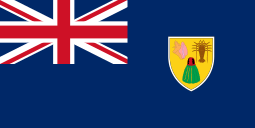
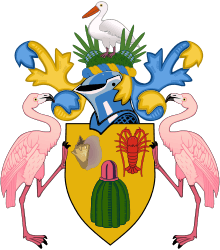

Countries.png)
